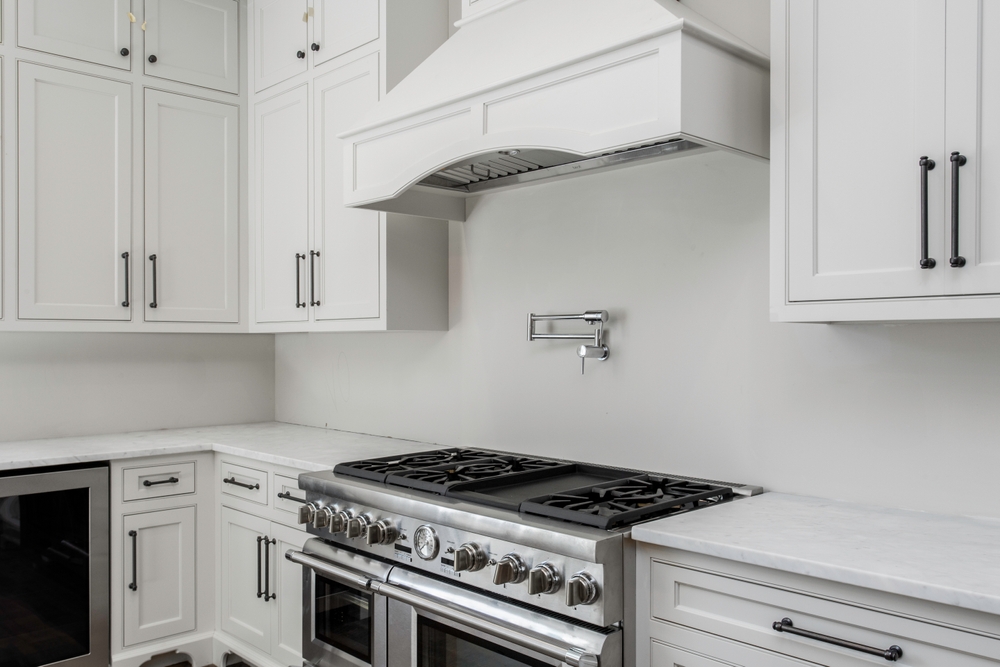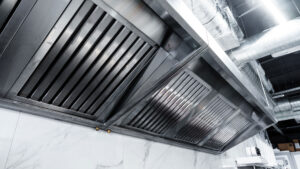What if the “fishy” smell you blame on last night’s dinner is really a sign your ventilation is failing?
They want fast answers and a clean kitchen hood. This section lays out the core truth: proper ventilation and targeted cleaning stop odors at the source. Hauslane notes that a ducted hood pulls cooking air outdoors, which is the most effective path for Phoenix range hood smell removal. In homes without ducts, ductless models recirculate through charcoal filters. These filters must be fresh to keep performance high.
Odors linger when grease and debris build up. Baffle filters help capture grease before it settles. But cabinets, walls, and floors also need control to avoid that stale film. A refrigerator set at 40°F or below stays safer and smells better.
A clean garbage disposal—refreshed with baking soda and white vinegar, followed by hot water and optional citrus peels—keeps sinks from seeding the air with funk.
They will also see how trash can sanitation with disinfectant and baking soda, regular HVAC filter changes every 30–90 days, and safe room fragrances like activated charcoal patches and wax warmers support freshening up your range hood. Installation quality matters, too. Airflow restrictions, a stuck damper, or even rainy, humid weather can push musty or “wet dog” odors back through exterior-vented hoods. The next sections explain How to get rid of smell in a Phoenix range hood? with practical checks for ducts, dampers, and filters—plus when to replace, not wash, black charcoal filters.
Key Takeaways
- Ducted ventilation is the most effective method for removing cooking odors.
- Charcoal filters in ductless hoods need regular replacement to maintain airflow and odor capture.
- Baffle filters reduce grease carryover; clean surrounding cabinets, walls, and floors to prevent buildup.
- Whole‑kitchen habits matter: keep the fridge at 40°F or below, clean the disposal, and sanitize the trash can.
- Change HVAC air filters every 30–90 days and use safe odor aids like activated charcoal patches or wax warmers.
- Weather, poor installation, and blocked ducts can introduce musty smells; inspect dampers and airflow paths.
- This guide focuses on range hood smell removal and freshening up your range hood with routine maintenance.
Understanding why Phoenix range hoods smell and how ventilation impacts odors
Kitchen odors build up when air and grease don’t move out properly. Ducted hoods send fumes outside, while ductless models use charcoal filters. If draw is weak or filters are old, getting rid of smells is harder.
Grease is a big problem. It coats filters and walls, trapping smoke and smells.
Moisture changes how a kitchen smells. Rain or high humidity can bring damp, musty air through vents. This makes it harder to get rid of smells on wet days.
Airflow is as important as power. Dirty filters, blocked ducts, or stuck dampers can weaken exhaust. Even small obstructions can trap humid air and make it hard to eliminate smells.
How you handle filters matters. Charcoal cartridges can’t be washed; once they’re full, they don’t work. Silver grease filters can be washed, but if they’re damaged, airflow drops.
Choosing the right system size is key. A low-CFM hood with a high-BTU cooktop can leave smoke in the kitchen. Ignoring manufacturer guidelines on duct length and turns can also slow down smell removal.
- Root triggers: moisture spikes, grease residue, and weak or blocked ducts
- Hardware factors: baffle filter condition, free-moving dampers, clear exterior caps
- Design fit: proper CFM for burner output and duct runs that reduce resistance
When ventilation works well, hoods pull out steam, smoke, and odors. But when it doesn’t, smells get trapped in filters and surfaces, coming back with every cooking session or humid day.
How to get rid of smell in a Phoenix range hood?
Start by improving airflow. Run the hood while cooking and for a few minutes after. This helps pull out steam and smoke. For ducted units, ensure the exterior wall or roof cap opens freely. Also, make sure the damper swings freely to prevent musty back-drafts during rain.
If the airflow seems weak, check for kinks or blockages in the duct. Also, confirm the hood’s CFM matches the range’s BTU output.
Next, clean inside the hood. Remove the silver grease filters and hand-wash them until they are clear of buildup. Then, reinstall them with the open end up to prevent them from touching the fan blade. For ductless models, replace saturated black charcoal filters instead of washing them.
Wipe the interior plenum and metal surfaces to remove grease films. These films trap odor and slow ventilation.
Don’t forget to clean beyond the appliance. Degrease cabinets, backsplashes, and nearby walls to prevent residue from re-smelling when heated. Consider using baffle filters or a carbon-lined splatter screen to curb splatter and absorb odors. Tighten duct joints and ensure the damper and cap suit local weather to reduce humid air intrusion.
If odors rise during rain, inspect for standing moisture or residue in the duct and cap area. Refresh the home by replacing HVAC air filters every 30–90 days. For quick relief after cleaning, place activated charcoal patches near the cooktop. Use wax warmers sparingly once sources are under control.
Tackle other odor sources. Deodorize a garbage disposal with 1/2 cup baking soda followed by 1 cup white vinegar. Wait 10 minutes, then run hot water. Add citrus peels for a bright scent. Wash the trash can with disinfectant and baking soda, let it dry fully, and insert a new bag.
- Range hood cleaning tips: wash metal grease filters, wipe the plenum, and match CFM to appliance heat.
- Range hood deodorizing techniques: replace charcoal filters, use activated charcoal patches, and prevent damp back-drafts.
- How to get rid of smell in range hood: restore airflow, remove grease films, control moisture, and clean nearby surfaces.
Whole‑kitchen odor control to support a fresh-smelling range hood in Phoenix, AZ
Grease carries most smells in kitchen range hoods. It sticks to floors, cabinets, and backsplash. Baffle filters and carbon‑lined splatter screens from Hauslane and All-Clad cut splatter at the source. They often go in the dishwasher, getting rid of odors from range hood parts.
Weekly floor care prevents films from building up. Sweep and mop with a DIY mix: 2 gallons hot water, 1 tablespoon liquid dish soap, 1/4 cup washing soda, 1/4 cup white vinegar, and a few drops of essential oil. Let floors dry fully to avoid damp smells and help freshen your range hood zone.
The refrigerator can seed stale air. They discard expired items, wash shelves and trays with hot, soapy water or a food‑safe disinfectant, and set the temperature at or below 40°F. An open box of baking soda sits in both fridge and freezer and gets replaced every three months.
Trash management is important. They rinse and disinfect bins, shake in 1/2 cup baking soda for 10 minutes, scrub, rinse, and dry before bagging. Scented liners from Glad help, but cleaning is key. This routine helps remove range hood stench from nearby cans.
For the disposal, a baking soda and white vinegar flush followed by hot water clears biofilm. Citrus peels add a light aroma. This step pairs with banishing odors from range hood filters by cutting smells that rise from the sink during cooking.
Air movement is important beyond the stove. They replace HVAC filters every 30–90 days to catch fine particles and improve circulation. After cleaning sources, activated charcoal odor absorbers from Filtrete or Moso and low‑heat wax warmers provide ambient freshness. They check fragrance safety for kids and pets.
These habits reduce odor load across the room. They help freshen up your Phoenix range hood and maintain steady performance during weeknight meals and weekend batches.
Conclusion
A fresh kitchen starts with good airflow. You need strong ventilation and a hood that matches the cooktop’s CFM. For ducted setups, make sure dampers move freely and ducts are clear.
For recirculating models, change out the charcoal filters and clean the grease screens. This keeps the fan working well. It helps remove smells from the kitchen.
Moisture can cause bad smells, like during rainy days. If smells get worse when it rains, check your vent. Seal or fix any leaks to keep humidity out.
Regular cleaning of the hood and lights gets rid of sticky stuff. Use baffle filters or carbon-lined screens to stop buildup. This helps keep the air fresh over time.
Keeping the whole kitchen clean is key in Phoenix, AZ. Sanitize trash cans and deodorize the disposal. Keep the fridge cool and refresh baking soda every three months.
Once you’ve tackled the main issues, add-ons can help. Activated charcoal and wax warmers can keep smells away. With the right ventilation, clean filters, and tight seals, your kitchen will stay fresh and ready for cooking.
Keep Your Kitchen Safe with Hood Hero In the Phoenix Metro
Hood Hero specializes in professional kitchen exhaust cleaning to keep your restaurant safe, compliant, and running smoothly. Trust the experts—schedule your hood cleaning service today!



